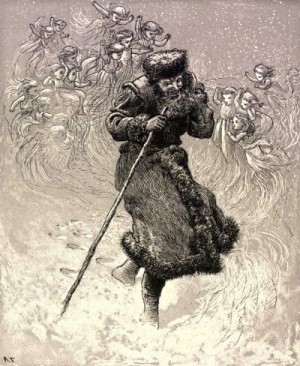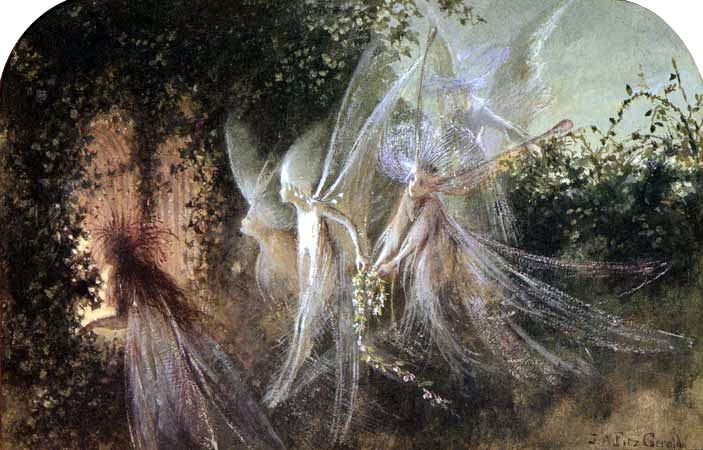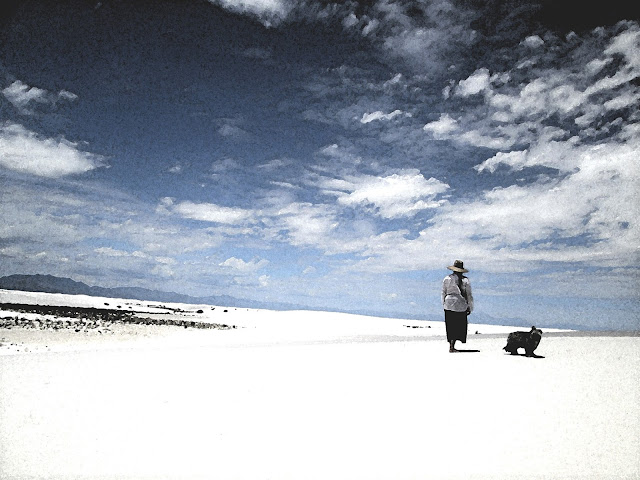I've always been fascinated with fairy lore, ever since early childhood, and to this day. Here's an article I take the liberty of sharing that beautifully explores some of the origins of the Fey. All I might add is that I also believe the Fairies, like the Katchinas, or the Numina, are also ancient personifications in myth of the nature spirits, the spirits of place, the Devas or elemental creators.
The Fairy Faith: An ancient indigenous European Religion
There are two different meanings to the term “Fairy Faith.” On one
hand, it simply refers to the old folkloric belief in fairies, and the
practices found therein. This meaning is usually ascribed to the modern
Celtic nations of Ireland and Scotland, where belief in fairies
lingered long into the modern era. In this sense, it is analogous to
other places where belief in fairy-like creatures continued even into
the present day, such as in Iceland and even in some Native American or
Canadian First Nations traditions.
The second meaning is found in the modern neo-pagan community. It
seems that the neo-pagan Fairy Faith sprung from the Wiccan community
somewhere around the 1970s in California. As the modern pagan movement
proliferated, many different paths developed. Some were divergent
variants branching off of Wicca, while others were born in the
reconstructionist movement (reconstructionist meaning attempts to
reconstruct the ancient indigenous religions of Europe, the
Mediterranean, and elsewhere, with historical accuracy). Yet more
versions of neo-pagan paths emerged that were influenced by these, but
took their own shape and form. So in the modern pagan community, the
Fairy Faith has various incarnations and meanings. This article will
focus mainly on the first definition, but will touch lightly on the
second.
Origins of Fairy Belief
The modern notion of fairy vastly different from that which our
ancestors knew, and even antiquated descriptions vary widely. While it’s
fair to say that the image of the fairy has changed a number of times,
it’s origins sprang from the murky haze of the Neolithic period.
In those times, ancestor worship was a common feature among Indo-European groups. Both the Celtic
Sidhe as well as the Germanic
Alfar
were originally both associated with burial mounds, and therefore
appear to have derived from ancestor worship. Human remains, and
especially highly revered ancestors such as tribal leaders, chieftains,
and great warriors were interred in mounds. A chieftain or hero of the
tribe would have been considered a tribal ancestor to everyone within
the tribe, especially as tribes were built around the structure of
kinship. Some scholars speculate that one possible origin of indigenous
European deities are persons of renown whose legends grew as they
continued to be remembered and honored by subsequent generations. The
word
sidhe originally meant the mound itself, but eventually came to mean the spirits who dwelt therein. And
, alfar is the Norse word from which the modern English word
“elf” derives.
Spirits of the mound are one direct foundation of elf and fairy
belief. But, the connection may have also come about indirectly by the
demotion of pagan gods during the conversion to Christianity. It has
been noted that belief in “small spirits” continued on in folk belief
for hundreds, and in some cases even a millennia, after conversion. The
epic gods may have been diminished into smaller spirits of the land. By
small, I don’t necessarily mean stature. But their power and roles were
lesser than the mighty and central role that the great gods once played.
For example, the Irish gods of the
Tuatha De Danann were later associated with fairy lore.
Even into the modern era, fairies continued to be associated with the
dead. In fact, some folklorists have noted that in folk accounts, there
isn’t a clear differentiation between ghosts and fairies (Spence, 87).
The Otherworld inhabited by fairies was often associated with the land
of the dead, and spirits of dead relatives and ancestors were often said
to be existing in the land of the fairies.
Some folklorists speculate that the notion of fairies could be a
cultural memory of the original inhabitants of Britain before they were
pushed aside by the incoming Celts. These people may have been smaller
in stature, and took to hiding in the forests and mounds as their
numbers because increasingly less. They may have engaged in guerrilla
war-like tactics as they became ever more adept at disappearing into
their wooded environment. Because they had less resources than the
Celts, the idea of the indigenous people swapping their sickly infant
and stealing a healthy one from his cradle is one hypothesis for
changeling tales.
So we can see that there are numerous influences and hypotheses for
the origins of fairy lore. To complicate things, the term fairy would
later be used to describe all manner of otherworldly spirit. There are
tales of demon or ghost dogs, for example, that are described as fairy.
The word “fairy” itself is a departure from the early notions of
sidhe and
alfar ancestor spirits. It comes from
fatae, meaning the Fates from classical mythology.
Fatae evolved into the noun
fay. Those who wielded the power of the
fay could bring about a state of enchantment called
fay-erie, which developed into the modern
fairy
(Briggs, 131). So, we can see that in the modern English speaking
world, the concept of fairy has numerous foundations, notwithstanding
the fact that most cultures worldwide contain their own unique beliefs
about fairy-like beings.
As Christianity arose in Celtic and Anglo Britain, the indigenous
fairy beliefs were grafted into the Christian lexicon, altering beliefs
further. Not only did powerful deities of mythology become shrunken into
fairy lore, but ideas about fairies changed to fit the Christian
paradigm. Instead of being spirits connected to Earth-centered
spirituality, it began to be said that fairies were the fallen angels.
Another story is that they were angels who had refused to take a side
during Lucifer’s revolt, so they were damned to exist between heaven and
hell for eternity.

Because the Judeo-Christian pantheon has only God (as trinity),
Satan, angels, demons, the Virgin Mary, and the saints, these
extra-biblical indigenous spirits had to be made to fit a biblical
context. Thus, they were relegated as demons by Church leaders. And
while this may sound very medieval, later Protestant Reformation writers
were especially forceful in their condemnation of fairies as demons.
People found to be interacting with fairies could be charged with
witchcraft.
In fact, fairies feature prominently in Scottish witch trial
records and were discussed in detail in leading demonology texts
written during the witch hunt era (for more on this, see “When Witches
Communed with Fairies” in Celtic Guide, Volume 2, Issue 10, October
2013).
Fairies and Faith
The image of the sweet little pixie with butterfly wings comes
strictly from the Victorian Era. In folklore, fairies have many
different descriptions. Spirits who live closely with humans, such as
domestic elves, tend to look like little old men dressed in antiquated
clothing. This likely connects to the
alfar’s evolution from an
ancestor spirit as described above. In an age when property was handed
down through the generation, it was believed that the original owner of
the homestead lingered on as guardian. The propitiation of domestic
spirits was common all across Europe, as well as elsewhere in the world.
Due to early Christianization of Celtic lands, domestic spirits are not
as common in Celtic folklore as elsewhere – except for in Scotland.
This is due to the heavy (but sadly overlooked) Germanic heritage in
Scotland. The brownies of Scotland fit snugly into the house-elf
tradition seen elsewhere in Germanic culture.
Another change in the modern view of fairies is their role as
benevolent and spritely elemental spirits. While these supernatural
beings were long associated with nature, it was often in a frightful
way. Far from the gentle winged fairy, we might have the gargantuan
leshy, guardian of the forests in Russian folklore.
Leshy is thought to be a cousin of the Celtic
green man,
another ancient guardian of the forest. Forest spirits were known to be
wily. They might lead the careless wanderer off their path and then
disappear leaving only their echoing laughter as the traveler finds
himself lost in the wilderness. Likewise, water spirits might seduce a
young fisherman only to pull him to his death beneath the waves.
Just as fairies evolved into innocuous, playful sprites in modern
times, they also went through transformations in the past. It seems that
every major age in civilization brings with it a change in fairy
belief. From ancestor mound spirits in the Neolithic, to more advanced
and god-like notions in the Bronze and Iron Ages, and then another
change when Christianity swept through Europe. Great and powerful
spirits were relegated to smaller realms. And, good or neutral spirits
became seen as strictly demonic.
We tend to view fairies, and the like, as not only innocuous, but
fairly silly. Those who profess to believe in them today are laughed at
by mainstream culture; derided as not only misguided, but even
dim-witted. Yet, from the beginning of Europe’s conversion to
Christianity, which began in the 7th century in England (13th century in
the Baltic, elsewhere in between) up through the Early Modern Era
(circa the 16th and 17th centuries), belief in fairies was quite
dangerous. The Church (both Catholic and Protestant) recognized fairy
belief as a vestige of pagan religion, which therefore made it a threat
to Christianity’s control over the peasantry. And, during the turbulent
years of The Reformation, fairy belief could get an individual accused
of witchcraft.
An excellent book on this is
European Mythology by Jacqueline
Simpson. Rather than focusing on the great gods of classic mythology,
this book focuses on fairies and folk tradition. She explains that there
is a huge difference between fairy belief found in folklore and the
other genre that often gets lumped together with it; fairytales. Simpson
says that fairytales are told mainly for entertainment, while folklore
“is concerned with supernatural forces as real entities, to be reckoned
with in the everyday world, and not just as material for entertaining…”
(Simpson, p8). These supernatural beliefs were part of the “folk
religion” of the common people. Folk religion is the corpus of beliefs
held by masses, which usually combines the formalized religion of the
elite (typically Christianity in the West and lands colonized by the
West, but also seen with other major world religions in other parts of
the world) with the indigenous beliefs of the people. This phenomenon is
also called “popular religion.” Another scholar who has studied the
merging of pagan and Christian beliefs in Britain is Karen Louise Jolly.
She explains:
Popular religion, as one facet of a
larger, complex culture, consists of those beliefs and practices common
to the majority of believers. This popular religion encompasses the
whole of Christianity, including the formal aspects of religion as well
as the general religious experience of daily life. These popular
practices include rituals marking the cycles of life (birth, marriage,
death) or combatting the mysterious (illness and danger) or asserting
spiritual security (the afterlife). Popular belief was reflected in
those rituals and in other symbols exhibited in society, such as
paintings, shrines, and relics” (Jolly, 9).
So, popular religion did not imply that the people held a notion of
self-identity as being pagan. They considered themselves strictly
Christian. But, many of their beliefs, traditions, and practices
retained elements of ancient pagan spirituality mixed with Christianity.
And, a large part of that in Britain, and elsewhere, hinged on the
belief in fairy spirits.
Spiritual Practices
As noted in the above quote, popular religion was expressed in the
folk practices of the people. One practice found all over Europe that
demonstrates the religious nature of fairy belief is the act of making
offerings. Offerings are made to deities in many world religions
through the ages to today. Even in Christianity, Jesus is called “the
sacrificial lamb” and his act of dying on the cross is supposed to
replace the Jewish practice of animal sacrifice. Animal sacrifice also
occurs today in Islam, as well as other religions.
The kinds of sacrifices traditionally given to propitiate fairy
spirits are more akin to offerings found in some Eastern faiths, such as
Hinduism or Buddhism today. Rather than slaughtering an animal for
blood sacrifice, offerings given to the fae are typically in the form of
food and drink, with grains and dairy featuring prominantly. This is
true for both domestic and certain types of nature spirits.
French scholar Claude Lecouteux studied folk practices related to
domestic spirits (such as brownies and other house elves) from all
around Europe for his book
The Tradition of Household Spirits. He states:
In all these rites, what stands out is
that the domestic spirit receives a portion of the household’s food as
an offering. It is regarded as a family member and treated as such. It
has a marked preference for dairy products, a feature it shares with
fairies who often perform the same duties as it does, even if they do
not remain in the house and only stop there during Twelve Days or other
dates (Ember Days, All Saints’ Day, and so on). (Lecouteux, p146).
(As an aside, note the similarity between what is described by
Lecouteux and our modern day custom of leaving cookies and milk out for
Santa Claus, that “jolly old elf.” We are not as separated from our
ancient customs as we might think!)
Offerings were not restricted only to domestic spirits, but also given to fairies residing in nature as well. In her book,
Spirits, Fairies, Leprechauns, and Goblins: An Encyclopedia,
scholar Carol Rose mentions that salt and bread are traditional
offerings given to the Russian forest guardian, the Leshy (Rose, p197).
And, lest we assume that a Slavic custom has no bearing on beliefs and
practices of the Celtic and Germanic people, Jacqueline Simpson reminds
us that:
[Folk tradition]is ‘European’ because
its main features are pretty consistent throughout Europe, despite
political and linguistic barriers; the range of activities ascribed to
fairies, for instance, remains much the same everywhere, whatever names
they are known by (Simpson, p8).
This is not to say that all European cultures are identical. But,
simply that they are related and share many characteristics, especially
as it pertains to folk tradition.
Offerings could take form other than food, especially when given to
nature spirits. Coins are a common offering to water deities and
fairies. You have probably given this offering yourself, throwing a coin
into a wishing well. Pagan belief carried a heavy dose of “you scratch
my back and I’ll scratch yours.” If you desire to receive something
from a spirit, i.e. make a wish, then you must give it something in
return. And, so, we still toss coins into wishing wells for the water
fairies in return for wishes granted today. Ribbons and pieces of cloth
strewn about the branches of trees are another such custom that
continues clear across Britain today.
Fairy Faith Today
The Fairy Faith lives on today, even if it is not recognized among
world religions. Many of us engage in certain behaviors without even
realizing we are acting out an ancient pagan fairy rite, such as leaving
out a food offering for Santa or tossing coins to a water well goddess.
Folklore lives on in many remote corners of Europe, where people still
insist that they have had an interaction with or siting of a fairy.
With the rise of neo-paganism in the past thirty or so years, fairy
beliefs have regained a home inside the lexicon of religion. While many
modern pagans assert a belief in fairies and other similar spirits as
one component of their wider belief system, others make fairy spirits
the central aspect of their religion. And, while this may seem like a
niche cultural subgroup, online book sellers offer numerous titles on
this subject, demonstrating that this niche has an ever growing
following.
Bibliography

Briggs, Katharine.
An Encyclopedia of Fairies, 1976.
Gundarsson, Kvedulf.
Elves, Wights, and Trolls, 2007.
Jolly, Karen Louise.
Popular Religion in Late Saxon England, 1996.
Lecouteux, Claude.
The Tradition of Household Spirits, 2000.
Lindahl, Carl, et. all.
Medieval Folklore, 2000.
Rose, Carol.
Spirits, Fairies, Leprechauns, and Goblins, 1996.
Simpson, Jacqueline.
European Mythology, 1987.
Spence, Lewis.
The Magic Arts in Celtic Britain, 1999.
Carolyn Emerick writes about history, myth and folklore in the Middle Ages. You can read about her work at her website www.carolynemerick.com






 So now I never go anywhere without my "magical pliers", which I like to think my Angel in Nebraska provided for me.
So now I never go anywhere without my "magical pliers", which I like to think my Angel in Nebraska provided for me.



































